
Ash in the parish of Braunton in North Devon is a historic estate listed in the Domesday Book. The present mansion, known as The Ash Barton estate is a Grade II* listed building.

Ash in the parish of Braunton in North Devon is a historic estate listed in the Domesday Book. The present mansion, known as The Ash Barton estate is a Grade II* listed building.
In AD 973 Edgar the Peaceful repossessed Braunton for the Crown through an exchange with Glastonbury Abbey, thus retrieving a strategically important estate at the head of a major estuary. Susan Pearce conjectures [1] that the King then placed a number of his thegns here providing each with a landholding which became the small estates which form an arc around Braunton to the north and east. These appear to have been members of three manors within the parish of Braunton, later known as Braunton Dean, Braunton Abbot and Braunton Gorges, of which latter manor Ash was part. [2] Ash was recorded in the Domesday Book of 1086 as ESSA, which states that immediately before the Norman Conquest of 1066 it was held by a certain Alward. [3]
Ash was amongst many estates granted by William the Conqueror to William Cheever (Latinised to Capra, "she-goat", from French chèvre). It is listed in Domesday Book as the 14th of his 46 landholdings in Devon. [4] His lands later formed the feudal barony of Bradninch. [5] William Cheever's tenant at Ash was a certain Ralph. [6] [7]
Somewhat later Ash was apparently granted in-chief to Reginald, Earl of Cornwall.

From Reginald, Earl of Cornwall, as recorded in the Cartae Baronum of 1166, Ash was held as half a knight's fee by Erchenbold, son of Simon de Flandrensis (Latin for "from Flanders/The Fleming"). The Fleming family held several estates in Devon (including Alverdiscott and Croyde) and was seated at nearby Bratton (later "Bratton Fleming"), in Braunton hundred, of which Erchenbald I (of Flanders) was the Domesday Book tenant of Robert, Count of Mortain, [9] whose lands later became the feudal barony of Launceston, [10] later the Duchy of Cornwall. In 1219 two thirds of the estate, by then for reason unknown called Ash Rogus (but see Holcombe Rogus), was given away as a marriage portion, but was bought back in 1229 by Erchenbald the Fleming.
The overlord of the Flemings at Ash appears to have changed from the feudal barony of Launceston back to the feudal barony of Bradninch as the 13th century Book of Fees records the tenant of Esse, Hakeston (Haxton in Bratton Fleming parish) and Duntingthon (Benton in Bratton Fleming) as "Baldwin le Fleming", holding from the barony of Bradninch. [11]
Ash Rogus then descended in its entirety through the Fleming family [12] until 1457 and the death of Christopher Fleming without male children.


In 1457 following the death unmarried and without children of Christopher Fleming, 5th Baron Slane (son of John Fleming (who predeceased his father Sir Christopher Fleming, 4th Baron) by his wife Amy Rochfort), his two sisters became his co-heirs to his Devon estates, the Irish estates passing under tail-male to David Fleming, uncle of the half blood to the fifth and last Christopher Lord le Fleming; which David was summoned to, and sat in the parliament of King Edward the Fourth, by the title of Lord David Fleming, Baron of Slane, and thus became a peer by a new writ of creation. The title Baron Slane (or le Fleming) of the 1st creation went into abeyance between the 5th Baron's two sisters, and was still in abeyance in 1835 when a petition for the peerage was heard in the House of Lords (the "Slane Peerage case"). The two sisters and co-heiresses were:
In 1472 James Fleming was in dispute with John and Patrick Bellewe over rents in Ash Rogus and Putsborough. [14] According to Westcote [15] at the end of the 16th century the Bellewes of Ash Rogus had also become lords of the manor of Braunton Gorges. In the Devon Muster Roll of 1569 [16] the liability of William Bellew, Esquire, to provide arms was assessed on his holdings in land at £100-200, the highest assessment in the parish of Braunton, and in the Subsidy Roll of 1581 [17] Richard Bellew was assessed as liable to pay £40 in tax, again, the highest in the parish.

A late 16th century [20] stone heraldic mural monument of Richard Bellew of Ash survives in Braunton Church, on the south aisle wall. It is said to have been taken from the former chapel at Ash. [21] It is a triptych split by use of superimposed orders of short Ionic columns into three rows and seven compartments. Within six of the compartments are escutcheons with heraldry sculpted in relief. The painted inscription and all painted colouring have been lost. It shows Richard's own shield at bottom centre, that of his father at top and on both sides in total 4 further shields of his father (again), grandfather, great-grandfather and great-great-grandfather.
The arms shown on the monument are as follows:


The Bellew family sold Ash in the 16th century to the Bourchier family of Tawstock, Earls of Bath, [45] feudal barons of Bampton, Devon. They were large landowners and amongst their holdings was the estate of Beare in the parish of Braunton. [46] A monumental brass to Elizabeth Bourchier (died 1548) survives in Braunton Church. She was a daughter of John Bourchier, 1st Earl of Bath and was the wife of Edward Chichester (died 1522) of Raleigh in the nearby parish of Pilton. [47]
Ash may have been tenanted during Bourchier ownership. A document of 1695 records that Richard Peard and others farmed the rents on half of "one chief messuage or barton called Ashrogus and other lands in the parish of Braunton". [48]

A small monumental brass (c. one ft high) survives in St Brannock's Church, Braunton, of Lady Elizabeth Bourchier (died 1548), daughter of John Bourchier, 1st Earl of Bath & wife of Edward Chichester (died 1522) of Raleigh, Pilton. She kneels at prayer before a prie dieu on which is an open book. The Gothic text inscription underneath is as follows:
"Here lyethe Lady Elyzabethe Bowcer daughter of John Erle of Bathe & sumtyme wyffe to Edwarde Chechester Esquyer the whyche Elyzabethe decessyd the XXXIIIth day of August in the yere of O_r Lorde God M Vc (i.e. 5*c) XLVIII apon whose soule God have m(er)cy".
The brass is a palimpsest, engraved on the reverse is the face of a knight, with helmet unfinished, apparently containing an artistic error which led to its abandonment & reuse.

Ash is said by Polwhele [49] to have passed to a junior branch of the family of Beare, lords of the manor of Huntsham. [50] The family of Beare (or "Bere") is ancient and the earliest member recorded is "Baldwin de Bere, lord of Bere" during the reign of King Stephen (1135–1154). [51] They remained at the estate of "Bere" for several generations but later moved to the manor of Huntsham which had been inherited by marriage. The location of "Bere" is uncertain, it may have been near Ash if it was the estate of Beare in the parish of Braunton described by Risdon (died 1640) as "the ancient dwelling of Richard de Charteray", which later descended via Baron FitzWarin to the Bourchiers, Earls of Bath. [52] It is also known as "Bear Charter". A mural monument survives in Braunton Church in memory of Balthazar Beare (1616–1682) inscribed as follows:
"Neare this place lyeth buried Balthazar Beare of Ashe in Brannton, Esquire, who dyed on the 10th of December in the yeare of our Lord 1682; the sonne of George Beare of Ashe, Esquire, whom he succeeded. And nigh him his wife Elizabeth, who dyed on the 5th of May 1661, daughter of Sir Walter Leach of Cadeleigh in this county, knight. Beare and Forebeare"
Above within a chaplet is an escutcheon showing the arms of Beare: Argent, three bear's heads and necks erased sable muzzled or, [53] with a crescent for the difference of a second son, impaling Leach, lords of the manor of Cadeleigh: Ermine, on a chief indented gules three ducal coronets or. [54] Sir Walter Leach (1599-pre-1637) was the eldest surviving son and heir of Sir Simon Leach (1567–1638), of Cadeleigh, Sheriff of Devon in 1624. George Beare was also seated at the estate of Frankmarsh, [55] near Barnstaple [56] and was a barrister of the Middle Temple and a judge of oyer and terminer during the reign of King Charles I. [57]
Ash is said by Polwhele [58] to have passed via Beare to Chichester, Bury and Lamley, who may or may not have been tenants

Ash then became the property of the Bassett family of nearby Heanton Punchardon and Umberleigh, in possession from at least 1780. [59] In 1822 Lysons recorded that it was the property of Joseph Davie Bassett of Watermouth Castle, and the tithe apportionment of 1840 recorded him as owner and Charles Dunn as occupier.
The Land Tax [60] records indicate that in 1780, the Ash Barton Estate was occupied by Robert Dyer, tenant of Joseph Davie Bassett. He was succeeded in 1784 by Philip Scott who remained until 1803. Then followed by Thomas Dunn, then Charles Dunn who was recorded in the tithe apportionment of 1840. The Trade Directories for Devonshire from 1851 to 1939 state that Charles Dunn was followed by Henry Passmore, then Henry Alford, then John Nicholas Reed and just before World War II, the Bowden Brothers. All of these were farmers at Ash Barton. [61]
A 16th century mural monument (see image above) to the Bellew family of Ash survives on the south wall of St Brannock's Church in Braunton and is said to have been taken from the old chapel at Ash. [62] In the mid-19th century, the local historian Harding mentioned in his notes regarding Ash ‘an ancient chapel still standing’. Coulter says [63] ‘the large, detached building to the rear of the main residence is thought by some to be the old chapel, but there is no particular evidence or architectural feature to support this.’ Although it would not be at all unusual for a high status residence at some distance from the parish church to have a private chapel, no licence for a chapel here has been found. Furthermore, despite local belief, the respondent to Dean Milles’ questionnaire of c. 1750 [64] made no mention of any chapel here either extant or ruined. Harding's words are at present the only historic documentary reference, and so without more positive evidence, the question of a former chapel must remain open.
The Ash Barton Estate lies beyond the boundary of the extensive area of long, narrow fields seen on the Braunton tithe map. These represent the engrossment and enclosure of the plough strips of medieval open field agriculture of which the Braunton Great Field is a rare surviving example. The system appears to have been bounded by Buttercombe Lane, which may represent a ‘transhumance’ route taking livestock to graze on the high ground of Fullabrook Down. To the south and east of Buttercombe Lane is an area of probably late medieval enclosure of what may have been the occasionally cultivated outfield. The Devon County Historic Landscape Characterisation survey describes the fields around Ash Barton as 15th- to 18th-century enclosures possibly based to an extent on medieval boundaries.
The occurrence of the term ‘Gratton’ in the names of two fields - tithe map numbers 1136 and 1138 - immediately to the east of the Ash Barton Estate may confirm this. The term is interpreted by Gover, Mawer and Stenton [65] as ‘stubble field’, but it is so common across Devon that it seems to have greater and more permanent significance than the seasonal ‘arish’. More likely it is descriptive of the outfield onto which stock would be turned to graze in between brief periods of cultivation. This would suggest that the settlement at Ash was established when the infield-outfield system had fallen away, perhaps relatively late in the pre-Conquest period.
To the north west is a field numbered 1133 on the tithe map and called in the tithe apportionment ‘Lower Forches’. This belongs within a group of ‘Forches’ field names here centring on a small triangle of land beside Buttercombe Lane called ‘Forches Green’. Here in the medieval period would have stood the gallows.
The estate is now owned and operated as a multi-purpose self-catering venue for hire by the Daukes family including weddings, parties, family holidays and corporate gatherings. www.ashbarton.com

Sir John St Leger, of Annery in Monkleigh, Devon, was an English landowner who served in local and national government.

Sir John III Chichester of Hall was member of parliament for Lostwithiel in Cornwall in 1624.

John Bluett of Holcombe Court, lord of the manor of Holcombe Rogus in Devon, was MP for Tiverton from 1628 to 1629 when King Charles I embarked on his Personal Rule without parliament for eleven years.

Sir John Chichester (1519/20-1569) of Raleigh in the parish of Pilton, near Barnstaple in North Devon, was a leading member of the Devonshire gentry, a naval captain, and ardent Protestant who served as Sheriff of Devon in 1550-1551, and as Knight of the Shire for Devon in 1547, April 1554, and 1563, and as Member of Parliament for Barnstaple in 1559, over which borough his lordship of the manor of Raleigh, Pilton had considerable influence.

Sir Lewis Pollard of Grilstone in the parish of Bishop's Nympton, Devon, was Justice of the Common Pleas from 1514 to 1526 and served as MP for Totnes in 1491 and was a JP in Devon in 1492. He was knighted after 1509. He was one of several Devonshire men to be "innated with a genius to study law", as identified by Fuller, who became eminent lawyers at a national level. He was a kinsman of the judge and Speaker of the House of Commons Sir John Pollard.

Hall is a large estate within the parish and former manor of Bishop's Tawton, Devon. It was for several centuries the seat of a younger branch of the prominent and ancient North Devon family of Chichester of Raleigh, near Barnstaple. The mansion house is situated about 2 miles south-east of the village of Bishop's Tawton and 4 miles south-east of Barnstaple, and sits on a south facing slope of the valley of the River Taw, overlooking the river towards the village of Atherington. The house and about 2,500 acres of surrounding land continues today to be owned and occupied by descendants, via a female line, of the Chichester family. The present Grade II* listed neo-Jacobean house was built by Robert Chichester between 1844 and 1847 and replaced an earlier building. Near the house to the south at the crossroads of Herner the Chichester family erected in the 1880s a private chapel of ease which contains mediaeval woodwork saved from the demolished Old Guildhall in Barnstaple.

The landed gentry and nobility of Devonshire, like the rest of the English and European gentry, bore heraldic arms from the start of the age of heraldry circa 1200–1215. The fashion for the display of heraldry ceased about the end of the Victorian era (1901) by which time most of the ancient arms-bearing families of Devonshire had died out, moved away or parted with their landed estates.

Joseph Prust (1620–1677) of Annery, in the parish of Monkleigh, Devon, was a royalist military commander during the Civil War. He was a lieutenant colonel.

The feudal barony of Bampton was one of eight feudal baronies in Devonshire which existed during the mediaeval era, and had its caput at Bampton Castle within the manor of Bampton.
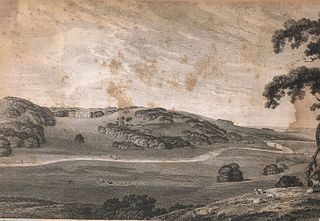
The historic manor of Tawstock was situated in North Devon, in the hundred of Fremington, 2 miles south of Barnstaple, England. According to Pole the feudal baron of Barnstaple Henry de Tracy made Tawstock his seat, apparently having abandoned Barnstaple Castle as the chief residence of the barony. Many of the historic lords of the manor are commemorated by monuments in St Peter's Church, the parish church of Tawstock which in the opinion of Pevsner contains "the best collection in the county apart from those in the cathedral", and in the opinion of Hoskins "contains the finest collection of monuments in Devon and one of the most notable in England".
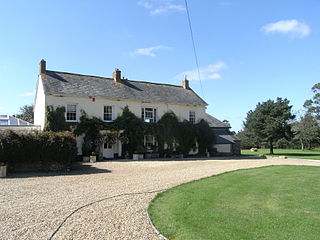
Way is a historic estate in the parish of St Giles in the Wood, Devon. It is situated about 2 miles (3.2 km) north-east of the village of St Giles in the Wood and about 4 miles (6.4 km) north-east of the town of Great Torrington. It was described by Hoskins (1959) as "the fons et origo of the mighty tribe of Pollard" and had been acquired by them from the de la Way family at some time before 1242.
Lewis William Buck (1784–1858) of Moreton House, Bideford, and Hartland Abbey, Devon, was Member of Parliament for Exeter 1826–32 and for North Devon 1839–57, and was Sheriff of Devon in 1825/6. A full-length portrait of Lewis William Buck by Francis Grant (1803–1878) was presented to him by the people of North Devon after he had served eighteen years as their MP, now displayed in the billiards room of Hartland Abbey, with his electioneering posters on each side.

Robert Incledon (1676–1758) of Pilton House, Pilton, near Barnstaple in North Devon, was a lawyer of New Inn, London, a Clerk of the Peace for Devon, Deputy Recorder of Barnstaple and was twice Mayor of Barnstaple, in 1712 and 1721. In 1713 as mayor he supervised the building of the Mercantile Exchange on Barnstaple Quay, as recorded on the building by a contemporary brass plaque and sculpture of his armorials. He built Pilton House in 1746.

Langley was a historic estate in the parish of Yarnscombe, Devon, situated one mile north-east of the village of Yarnscombe. It was long the seat of a junior branch of the Pollard family of Way in the parish of St Giles in the Wood, Devon, 3 miles to the south.

Sir William Huddesfield of Shillingford St George in Devon, was Attorney General for England and Wales to Kings Edward IV (1461–1483) and Henry VII (1485–1509). He built the tower of St George's Church, Shillingford.
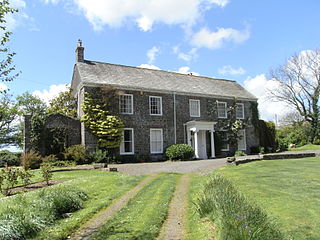
Thuborough in the parish of Sutcombe, Devon, England, is an historic estate, formerly a seat of a branch of the Prideaux family, also seated at Orcharton, Modbury; Adeston, Holbeton; Soldon, Holsworthy; Netherton, Farway; Ashburton; Nutwell, Woodbury; Ford Abbey, Thorncombe, all in Devon and at Prideaux Place, Padstow and Prideaux Castle, Luxulyan, in Cornwall. The present mansion house, comprising "Thuborough House" and "Thuborough Barton", the north-east block, is a grade II listed building.

Sir Simon Leach (1567–1638) of the parish of All Hallows, Goldsmith Street, Exeter and of Cadeleigh, Devon, was Sheriff of Devon in 1624. His surviving monument in St Bartholomew's Church, Cadeleigh is the largest of its type in any Devon parish church.
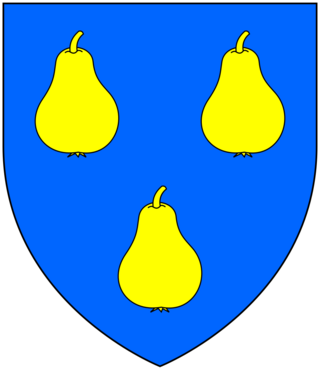
Sir Hugh Stucley (1496–1559) was the lord of Affeton in Devon, and Sheriff of Devon in 1545. His third son was Thomas Stukley, known as "The Lusty Stucley".
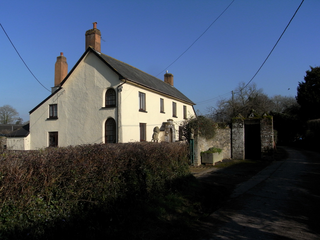
Moor Hays is a historic estate in the parish of Cullompton in Devon, England. It is stated incorrectly to be in the nearby parish of Burlescombe in Tristram Risdon's Survey of Devon. The estate is not to be confused with Moor Hayes in the parish of Washfield, about 3 miles north-west of Tiverton, another ancient farmstead, which since 2005 has been the site of a large housing estate named "Moorhayes".
The manor of Alverdiscott was a manor situated in north Devon, England, which included the village of Alverdiscott.